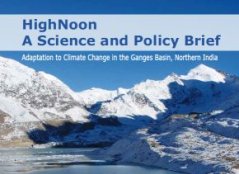Noticias
HighNoon Science and Policy Brief - Adaptation to Climate Change in the Ganges Basin, Northern India
The HighNoon project has come to an end.

The principal aim of this EU FP7 project was to assess the impact of Himalayan glaciers retreat and possible changes of the Indian summer monsoon on the spatial and temporal distribution of water resources in northern India.The project further aimed to provide recommendations for appropriate and efficient strategies that strengthen the cause for adaptation to hydrological extreme events through a participatory process.
Major findings
- Gradual wide-spread warming over northern India is projected by Regional Climate Models (RCM). Temperatures in the Ganges basin are expected to increase by an average of about 2 °C by 2050 and 4 °C by 2100, being more pronounced over mountainous areas.
- Annual total precipitation changes across northern India are less certain. Against a backdrop of considerable decadal variability, the slight increase in precipitation to 2050 indicated by the RCMs is unlikely to be significant.
Recommendations
- Rates of melt and accumulation of Himalayan glaciers are still not well understood. More research is needed on benchmark glaciers so as to better understand their dynamics, evolution, and response to climate change.
- The network of benchmark glaciers for sustained measurements should be extended to represent the large diversity of Himalayan glacier environments so as to allow better prediction of future melt water yields.
Download the Policy and Science Brief with all major findings and recommendations.